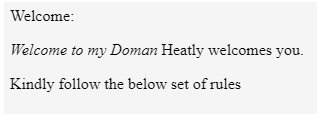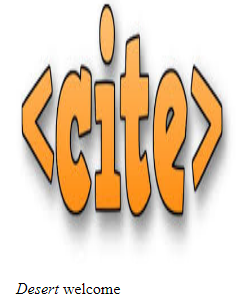Updated March 20, 2023

Introduction to Cite Tag in HTML
The following article outlines the Cite Tag in HTML. In HTML, different sets of tags are used for different purposes. One of the tag elements is to identify the sources of a quote is <cite> tag. It’s an underused element, it provides some little, and no presentational value is only there add to semantic information about using tags <blockquote>and <q> element tags. The <cite> tag is used to identify the creative work and names of a referenced for creative work. Tag, which is also used for the standard format to follow for customized ones like HTML validation, has the following standards to follow the rules to validate the user requirements. We will see the uses, purposes, and usages of the <cite> tag will provide below.
What is Cite Tag in HTML?
Two tags are mainly used for highlighting the text which is to be given for the user end. Generally, we have the set of quotes to highlight the sentences like “Capitalize the first letter of a quote from a source, put a comma for before full quotes, use some quotation marks for emphasizing the word or phrases, even though we have used punctuation for inside the quotation marks,” these are some rules which have to be followed for the highlighting the sentences.
Here we have used the <cite> tag for just highlighting the words in html.
Syntax:
<blockquote cite="words or any URLs">
Examples words
</blockquote>More ever we also use the below syntax also using <p> tag
<p>
<cite>
---Examples words-------- </cite>
</p>In the above two syntaxes, we have used two tags, in<p> is a paragraph tag if we use these tag that is used will give the input and has a list of paragraph format that time we will mark any of the words which are to be highlighted means we use the words in just <cite> tag it will automatically highlight the quotes.
The same thing when we are using <blockquote> tag itself we use <cite> if suppose we have blocked the particular URL or sentences or any example words is not to be viewing in end-user time, this tag will be very useful for the scenario, i.e. the words inside the cite tag in blockquote will not display with the viewer side.
Examples for Cite Tag in HTML
Let us see some examples that need to be made more clear:
Example #1
<html>
<head>
<style>
cite {
font-style: italic;
}
</style>
</head>
<body>
<p>Welcome:</p>
<p><cite>Welcome to my Doman</cite> Heatly welcomes you.</p>
<p>Kindly follow the below set of rules</p>
</body>
</html>Output:
In the above example, we will use the <cite> tag in css styles file; we’re setting the fonts like Italic so when you display the text inside of the <cite> tag is to be in an Italic format, If we use different fonts, colors and any of the settings that are related to css styles, we also use them.
Example #2
<html>
<body>
<h1>Welcome</h1>
<p>Welcome<p>
<blockquote cite="www.welcometomydomain.com">
Welcome userWelcome userWelcome userWelcome userWelcome userWelcome userWelcome userWelcome userWelcome userWelcome userWelcome userWelcome user
</body>
</html>Output:
In the above example, we have used the <cite> tag inside the <blockquote> tag; the particular URL that is not displayed in the browser is automatically disabled when we use the cite tag inside the blockquotes.
Example #3
<html>
<body>
<img src="C:\Users\SK-1\Downloads\New folder\images.jpg" width="220" height="277">
<p><cite>Desert</cite> welcome</p>
</body>
</html>Output:
In the above example, We’re using images like jpg format inside the cite tags. We have set the height and width of the customized images. We also use the cite tag in some other libraries like jquery, Angular, React JS, Vue. Even though we use HTML 5 in the <cite> tag, we also use the utilities like videos, music, etc. HTML Attributes contain one or more attributes used to add the tag to provide more pieces of information inside the browser page and how the tags should appear or behave on the user information.
Three kinds of attributes used for adding HTML tags:
- ElementSpecific
- Global
- Event Handler
The above three are generally used for the functions like tags perform inside in the html.<Cite> tag supports both Global and Event Handler attributes. It also belongs to Flow Content, Palpable content and Phrasing Content categories also.
Browser Compatability
Generally, we’re faced with browser compatibility issues when we’re using some operations inside the html one browser is working fine, and another browser isn’t working as we’ve ever been dealing with this kind of issues in the Internet Explorer; we’re also adding plugins like a flash, etc. that’s helpful for running the application inside the browser.
The same thing when we use the <cite tag, it also supports browsers like “Chrome(both web and mobile), Firefox(both web and mobile), Internet Explorer(IE), Edge Mobile, Opera(both mini for web and mobile), Safari(both mobile and web and also WebKit). Sometimes the application is not supported in the mobile Interface like we are using “UC Browser(both web and mobile and also UC Mini). It’s not supported every time we need to change the browser to run the application when we need to address the problem in development mode.
Differences between HTML 4 and HTML 5
Once we update HTML 4 to HTML 5, we have a set of features to use the user specifications. Including Images, Audio, and some Animations are additional features if we use the HTML 5 version but do not have animation functionality in HTML 4. Here we have some basic difference for the < Cite > tag for both HTML 4 and HTML 5.
Cite Tag in HTML 4: In HTML 4, it defines only the citation.
Cite Tag in HTML 5: In HTML 4, it defines only the title of the work.
Example in HTML 5
<html >
<body>
<cite> "Welcome"</cite> is a
<cite> User</cite> site.
</body>
</html>Output:
In the above example, we are seeing the cite tag just it’s the title of the task if you are using the same coding in the HTML4 version is the citation of the task.
Conclusion – Cite Tag in HTML
The basic principles of html when we use a different set of tags, such as predefined and unique tags, to perform operations both manually and automatically on the basis of user requirements. Thus, if we have to evaluate the user prospectus and its specifications for Fullfledged, then it will be used for potential developments or Current Trends.
Recommended Articles
This has been a guide to Cite Tag in HTML . Here we discuss the introduction, syntax, examples and three kinds of attributes used for adding HTML tags. You may also have a look at the following articles to learn more –





